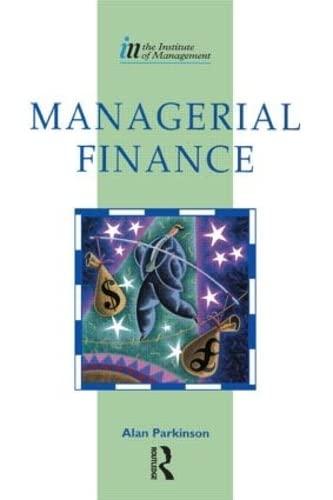Question
The following questions all concern a proposal to build a dam to reduce the chances that farmers will be subject to flooding and to increase
The following questions all concern a proposal to build a dam to reduce the chances that farmers will be subject to flooding and to increase the availability of water for farm irrigation. Assume that the cost of building the dam is predicted to be $40 million, that net benefits from the dam are predicted to be $6.0 million during each of the 100 years that the dam is expected to operate, and that at the end of the 100 years the dam has no salvage value.
a. Is the option value of the dam likely to be positive, negative, or zero? Briefly explain.
b. Compute the net present value of the dam, assuming that annual net benefits are received at the end of each year. In making this computation, use the conventional approach to discounting and a discount rate of 8 percent. [Please show your work clearly so that I can give you partial credit if it is appropriate to do so.]
c. Does it matter whether the 8 percent discount rate you just used was based on a real or a nominal interest rate? Which should you be using? Briefly explain.
d. Suppose there is uncertainty surrounding the values you used to compute the net present value of the dam in (b). Specifically, benefit-cost analysts believe the discount rate could be as high as 10 percent or as low as 5 percent, the initial cost
of building the dam could be as high as $45 million or as low as $35 million, and annual net benefits could be as high as $7 million or as low as $5 million. Given your answer to (b), indicate whether a best-case analysis or a worst-case sensitivity analysis is more appropriate, make the calculations required to do the analysis you selected, and briefly discuss what your calculations imply about whether the dam should be built.
e. Re-compute the net present value of the dam using the shadow price of capital method. In doing this, again assume that the dam would cost $40 million to build and generate annual benefits of $6 million. Also assume that the social rate of time preference is 3 percent and that the shadow price of capital is 2.0. Further assume that all of the costs of building the dam displace private sector investment and that 20 percent of annual net benefits from the dam flows into investment and 80 percent flows into consumption. [Again, please clearly show your work.]
f. Because the dam would produce water for irrigation, it would increase the productivity of the farms using the water. One can think of this new source of water as shifting the supply curve of, say, wheat downward. Assume that the price of wheat is artificially supported at a level above the competitive market price, and that this higher price, which is called a "target price," is the one farmers look to in making their production decisions. Wheat is sold at the price required to induce consumers to purchase all that farmers produce. The government uses tax revenues to pay farmers the difference between this price and the target price. Would building the dam cause the tax revenues paid to farmers to increase or decrease? Use a graph to demonstrate this.
Step by Step Solution
There are 3 Steps involved in it
Step: 1

Get Instant Access to Expert-Tailored Solutions
See step-by-step solutions with expert insights and AI powered tools for academic success
Step: 2

Step: 3

Ace Your Homework with AI
Get the answers you need in no time with our AI-driven, step-by-step assistance
Get Started


